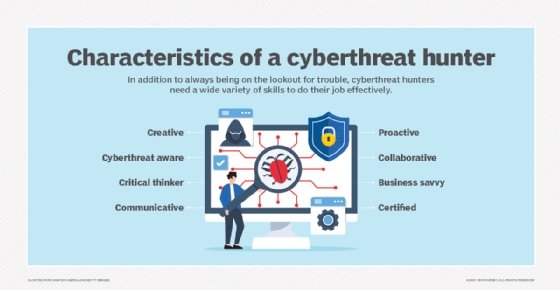What is a cyberthreat hunter (cybersecurity threat analyst)?
A cyberthreat hunter, also called a cybersecurity threat analyst, proactively identifies security incidents that might go undetected using automated security tools, such as malware detectors and firewalls.
Cyberthreat hunting involves monitoring network traffic, Internet Protocol (IP) addresses, endpoints, data sets and insider threats -- often in real time -- to uncover potential security incidents that might otherwise go undetected. In this way, the hunter provides threat intelligence and an additional defense against cyberattacks and advanced persistent threats.
Why is cybersecurity threat hunting important?
Predicting malicious activity is challenging because many new threats have no apparent indicators. The only way to stay ahead of these emerging threats is to proactively seek them out and prevent them from occurring.
Instead of waiting for potential threats to emerge, the threat-hunting process centers around searching the organization's environment for anomalies that might indicate vulnerabilities and then implementing proactive threat hunting to validate assumptions and mitigate risks.
In essence, threat hunters assume that threat actors already have access to the environment they're investigating. They evaluate all systems until they find any malicious activity and remediate the causes.
What tasks are involved in cyberthreat hunting?
The cyberthreat hunter's job is to supplement and reinforce automated systems that detect or anticipate cyberthreats. As the review process uncovers patterns for initiating attacks, the security organization can use that information to improve its automated threat detection software.
A cyberthreat hunter regularly does the following:
- Searches for vulnerabilities and risk factors in data and systems.
- Stays current on the latest innovations and cyber attack strategies in cybersecurity.
- Studies trends in cybercrime around threat actors' behaviors, tactics and goals.
- Analyzes collected data to find potential anomalies in the security environment.
- Eliminates any risks and vulnerabilities.

Cyberthreat hunting methodologies
Threat hunting generally revolves around one of the following three industry-accepted methodologies:
- Hypothesis-driven investigation. Hypothesis-driven investigations are driven by a large amount of crowdsourced data that provides insight into cybercriminals' latest tactics, techniques and procedures (TTP). Threat hunters use TTP insight to investigate whether those behaviors exist within the organization's current environment.
- Indicators of compromise-driven investigation. IOCs are found in forensic artifacts and identify activity that indicates potential threats. Investigations driven by IOCs use threat intelligence to identify the effective threat within the organization's environment. Potential IOCs include network-based artifacts, host-based artifacts and authentication-based artifacts.
- Machine learning investigation. Machine learning can aid threat hunting by combining analysis and machine learning to sift through large amounts of data, searching for anomalies that might indicate a potential threat.
All these methodologies combine threat intelligence, human effort and advanced cybersecurity technologies to proactively investigate an organization's systems and data to mitigate or prevent security incidents.
Steps in the cyberthreat hunting process
The cyberthreat hunting process is often performed using the following steps:
Step 1: Prepare
The cyberthreat hunter looks for unusual data or activities. If these are detected, they go to the specific system or network areas where the anomalies were detected. Often, there's no ready explanation for an unexpected anomaly, so the cyberthreat hunter uses critical thinking to devise a theory or hypothesis that might explain the anomaly.
Step 2: Analyze
At this point, the cyberthreat hunter begins a deep dive into the issue using specialized tools such as endpoint detection and response software or automation that can read and analyze computer logs. The cyberthreat hunter continues investigating until an explanation can be articulated or the threat is determined to be a false alarm.
Step 3: Act
The cyberthreat hunter gathers as much information as possible about a detected and looming threat. They then communicate this information to the central security team so they can plan for, eliminate and mitigate the threat.
Cyberthreat hunting tools
Several tools supplement the human effort expended by cyberthreat hunters. These include the following:
- SIEM tools. Security information and event management (SIEM) tools help threat hunters by using automation to collect and analyze large amounts of cloud-based data from monitoring tools and other sources to unearth previously unidentified threats.
- Security monitoring tools. Security professionals use the data collected from security monitoring tools to help provide a full picture of potential threats.
- Analytics tools. These tools enable the threat hunter to better visualize data to help them better identify correlations between data sets that might indicate an attack.
- Threat intelligence sources. Threat hunters use threat intelligence data on malicious IP addresses, malware hashes and other threat indicators found in various forms on the internet to support their analysis and investigation efforts.
What's the difference between threat hunting and threat intelligence?
Although threat hunting and threat intelligence are two cybersecurity components, they serve distinctly different but complementary purposes.
The cyberthreat hunter is actually on the hunt for malicious viruses, malware and other suspicious activity that could already exist in latent states in systems or on the network. The job of the cyberthreat hunter is to ferret out silent threats before they become active and to detect patterns of system behavior that could suggest the presence of malicious malware or viruses.
The cyberthreat hunter assumes that latent viruses and malware are likely already in the network and that these entities must be hunted down and eliminated before they're activated.
In contrast, a cyberthreat analyst surveys the threat landscape by conducting daily cyberthreat intelligence via monitoring and, where necessary, threat fighting if viruses or malware are detected and active. The analyst assumes that malware and viruses aren't necessarily present but could become present at any time.
The cyberthreat hunter and the cyberthreat analyst use similar tools. The distinction between the two is that the cyberthreat hunter is the aggressor, discovering and destroying malicious code before it activates, while the cyberattack analyst is in a more neutral, even defensive role, using threat intelligence gleaned from monitoring systems, detecting abnormal activities and combating threats if they arise.
What types of organizations use cyberthreat hunters?
Typically, cyberthreat hunters are employed by large-scale, enterprise organizations that are particularly vulnerable to cyberattacks. Among the industry sectors that use cyberthreat hunters are financial services, insurance, aerospace, scientific research companies and others with highly sensitive information.
Threat hunters work within a security operations center (SOC) and lead in their threat detection and incident response activities. They're often managed by the organization's chief information security officer, who works with the chief information officer to coordinate enterprise security.
Threat hunting can be assigned as an additional duty to one or more security professionals within a SOC, or they might be assigned full-time threat hunting duties. For smaller organizations, threat-hunting services are typically outsourced to managed security service providers that offer security monitoring and management to several organizations at once.
An additional option is to create a threat hunting team that rotates security engineers temporarily into the threat hunting role and then has them return to their usual jobs within the SOC.
Skills required to become a cybersecurity threat hunter
Security threat hunters must be able to uncover threats that could be concealed deep within networks and systems. Key skill areas and training certifications for cyberthreat hunters include the following:
- A strong background in data analysis so data can be critically evaluated within the contexts it appears.
- The ability to recognize data and processing patterns that could signal a malware intrusion.
- An understanding of networks and how they transmit data, check for security, use encryption, and enable and disable access to network resources.
- Background in data forensics, which could include gathering evidence, documenting it and developing it into a likely scenario of a committed or contemplated cybercrime.
- Certifications relevant for a cyberthreat hunter, including the following:
- Certified Information Systems Security Professional.
- Certified Ethical Hacker.
- GIAC Certified Incident Handler.
- Certified Information Security Manager.
Employment outlook for cybersecurity threat hunters
According to global market research firm The Business Research Company, the cyberthreat intelligence market is poised to grow from $11.58 billion in 2024 to $14.16 billion in 2025. With this market growth comes opportunities.
Organizations typically look for professionals with at least three to five years of experience in cybersecurity or a related field and a bachelor's degree in computer science, IT or cybersecurity. Senior roles might require a master's degree.
In 2024, the median salary for a cyberthreat hunter was $137,000, with the top 10 percent of threat hunters earning around $200,000 annually.
Learn the signs that could suggest the presence of an insider threat within your organization and how to neutralize the threat before damage is done.







